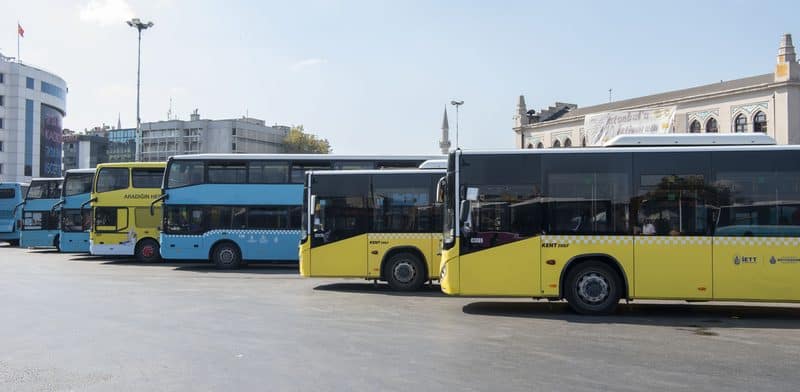
All of us have used a bus at some point in our lives. Buses have significantly advanced human civilization and linked cities together. While most people know what a bus is and what they are used for, few question just how many there are in the world.
Due to the enormous demand and importance of buses, most countries globally have thousands, with many opting for electrical versions going forward.
There are more than 3 million operational buses globally. Buses have experienced enormous demand for nearly 200 years, with many countries designing and building their entire road network around them. Many western countries have started purchasing electrical models.
The global bus industry’s scope is astronomical, and it is expected to increase further over the coming decade. Currently, just over 400.000 buses are classified as electric, which aligns with the industry’s aim of reducing their impact on global carbon emissions.
To grasp how massive and critical the bus industry is to most counties and the global economy, read this article’s end.
Buses In The World
In 2022, Bloomberg New Energy Finance indicated that there are just over 3 million operational buses globally. Interestingly, more than 400.000 electrical bus models are currently in use globally.
The global bus industry has been unfairly labeled as one of the main culprits of global emissions and warnings. Since more than 3 million buses are currently being used by various governments globally, they will inevitably be targeted for emitting a massive amount of carbon dioxide into the atmosphere each year.
However, the global bus industry has noticed and accounted for their global carbon dioxide emissions by introducing electrical bus models.
As of 2022, just over 15% of the world’s bus fleet is electrical. Electrical buses are far more economical and environmentally conscious than their diesel counterparts, with the industry aiming to replace an additional 30% of diesel buses by the end of the decade.
Number Of Buses Per Country
The number of buses in each country inevitably differs. Some countries rely on buses far more than other, more developed countries.
In undeveloped and third-world countries, buses are often the only mode of transport for its citizens. However, buses remain important to developed societies, demonstrating their global popularity and importance.
Number of heavy-duty buses per region:
- China: 57.000
- India: 36.500
- South America: 30.700
- Europe: 16.000
- Russia: 14.500
- North America: 6.800
- Other Markets: 39.000
Since buses were introduced as a mode of public transport more than 200 years ago, their importance to economies, governments, and citizens cannot be understated.
Buses have joined cities together, enhancing economic development by allowing people to travel further to their places of work, becoming a vital cog of any global society.
While the global bus industry took a knock when the horrific 2019 Covid pandemic shut the world down, it has since recovered. In 2021, more than 170.000 buses were sold worldwide, which marks a year-on-year growth of just over 1%.
While 1% is an insignificant growth, it is critical as it indicates the bus market is as vital as ever and should continue to experience growth over the coming decade.
Industry experts predict that the number of buses in the world is set to continue increasing. In line with accurate economic models, there should be more than 5 million buses worldwide, indicating their unmatched importance to every country globally.
Why Are There So Many Buses In The World?

As most people know, buses are large four-wheeled vehicles specifically designed to safely, inexpensively, and safely carry as many passengers as possible.
Furthermore, buses can transport a far greater number of people compared to cars or vans. Usually, buses can carry in the region of 50 people per trip, resulting in them being frequently utilized by global governments in urbanized areas for tourism, school transportation, work transportation, and officially scheduled transportation services.
Bus services are additionally advantageous due to their revered reliability, cheap prices, and mass transportation capabilities.
In addition, countries started to introduce bus lanes and other forms of rapid bus transport systems throughout their cities, which allows people to quickly travel from their homes to their places of work.
The rapid nature of global bus transportation systems demonstrated their incredible importance to global economies, financial development, and citizens.
Moreover, many modern busses come standard with Wi-Fi, ablution facilities, and extra legroom due to their sophisticated designs. Modern technological and design developments have significantly enhanced global sales numbers.
What Is The State Of The Global Bus Market?
Many people underestimate the size and importance of the global bus market. The global bus market is an accurate economic indicator, demonstrating consumer confidence and employment rates.
In 2022, it was reported that the global bus industry is worth more than $48 billion, which is set to increase to more than $75 billion by 2027.
Despite the industry’s severe knock from 2019 to 2021, it has experienced a return to pre-pandemic numbers. The continued strength and growth of the global bus market are directly related to global economic growth numbers.
Recent technological enhancements have aided the global bus industry through bus transportation systems.
Furthermore, technological innovations and the continuous rise of electrical buses should assist the industry, with global demand predicted to increase by about 8% yearly until the end of the decade.
By 2027, most analysts agree that the global market will be more than $75 billion. The staggering size of the global bus market should not be underestimated, with it being influential for economic growth, development, and advancement.
Most people use buses for inexpensive, reliable, and irreplaceable daily transport to and from work. The size and scale of the global bus industry are significant, with its unmatched intrinsic value being responsible for millions of people’s livelihoods.
The number of buses globally, just over 3 million, is a reliable indicator of positive economic and future unemployment rates.
The Bus Industry’s Changes Over The Next Decade
It can therefore be said that over the last decade, most transport industries have become victims of stringent emission laws.
The bus industry is no exception; however, the recent introduction of desirable, appropriate, and financially viable electrical bus models has decreased yearly emissions substantially.
Furthermore, despite buses being responsible for large amounts of toxic gas emissions yearly, the amount of emitted pollution per passenger is far less than other modes of transportation.
The combination of a low emission per passenger number and modern electrical buses has aided industry growth.
Buses are set to maintain their reputation for being one of the best advertising models worldwide, with thousands of companies opting to display their advertisements on either side of city buses.
It can be said that the number of buses worldwide is set to continue increasing, clearly demonstrating the unrivaled importance of the industry to most countries.
Conclusion
The global bus industry’s size cannot be understated, with more than 3 million buses currently operating in most cities.
Since their introduction more than 200 years ago, buses have become irreplaceable for their unmatched ability to provide inexpensive, safe, and efficient transport.
If you want to compare these numbers to other types of vehicles, I listed how many trucks and bicycles there are in the world in these posts:
